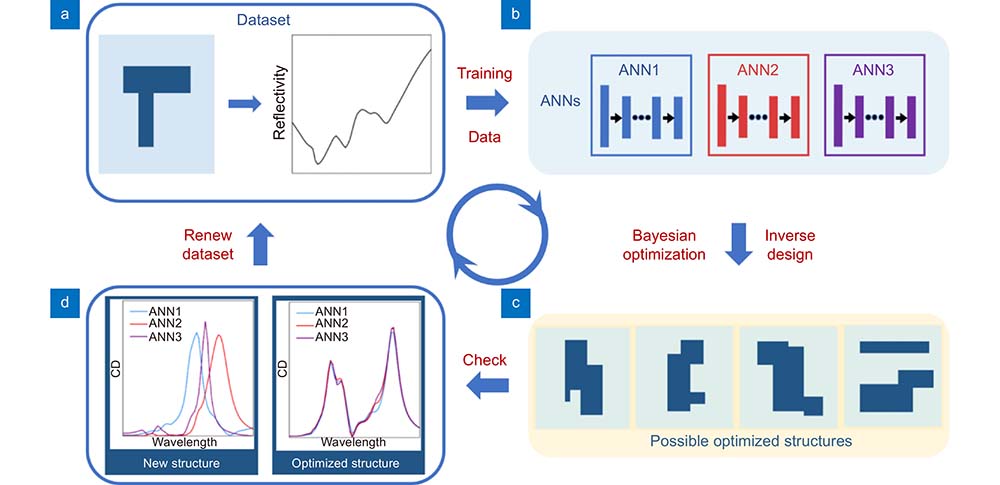- Opto-Electronic Advances
- Vol. 6, Issue 10, 230057 (2023)
Abstract
To execute the proposed scheme, the chiral unit to be designed is parameterized by 40×40 units encoded with 0 or 1, which represents that a gold cuboid or air exists at that position. ANNs achieve the mapping between the optical response spectra and the matrixes which represent the geometry. As last, three chiral metasurfaces with different CD peak frequencies are designed. The chiral metasurfaces are also fabricated and measured to validate the proposed method. The experimental results are consistent with the designed results. The frequency shifts of the CD spectra caused by chiral molecules are also measured using left-glucose and right-glucose solutions controlled by microfluidic channels. The resonance wavelength shifts between enantiomers of glucose with opposite chirality reach 7 nm, which indicates enhanced sensitivity of the chiral molecules.
![]()
Figure 1.
The proposed method improves the quality of the training dataset and reduces the electromagnetic simulation amounts compared with classical exploration methods. Chiral nanostructures with significant CD values and high chiral detection sensitivity have been successfully designed and fabricated. Besides the demonstrated chiral nanophotonic designs, other optical properties can be also designed since the algorithm is universal for any physical meanings of the optical responses. This work envisions the promising applications of AI in nanophotonic and electromagnetic designs.
Chiral plasmonic nanostructures have been employed to enhance the interactions between the optical waves and the chiral molecules. Common dichroism technologies are based on circularly polarized waves, i.e. the spin angular momenta (SAM) of photons
Chirality is a fundamental physical property which means that an object or structure cannot be superposed to its mirror image. It plays important role in biomedical sensing, as enantiomers with opposite handedness lead to dramatically different biological effects. However, it is challenging to detect trace-amount enantiomers, since the chiral bio-molecules are quite smaller than the optical wavelengths and present weak dichroism signals
However, the interactions between chiral molecules and chiral nanostructures are complex. Different biomolecules may require different nanostructures to reach the optimally enhanced dichroism signals. Hence, the design of the chiral nanostructures consumes huge computing resources in iterative electromagnetic (EM) simulations. Artificial intelligence (AI) emerges as a powerful tool in nanostructure designing, which can deal with more complex problems and larger-scale data compared with traditional optimization algorithms. AI has been successfully used in the design of metasurfaces, photonic crystals, integrated wavelength routers, etc.
In a recent paper published on Opto-Electronic Science
References
[1] LD Barron. Molecular Light Scattering and Optical Activity(2009).
[2] S Droulias, L Bougas. Chiral sensing with achiral anisotropic metasurfaces. Phys Rev B, 075412(2021).
[3] Y Zhao, AN Askarpour, LY Sun, JW Shi, XQ Li et al. Chirality detection of enantiomers using twisted optical metamaterials. Nat Commun, 14180(2017).
[4] W Brullot, MK Vanbel, T Swusten, T Verbiest. Resolving enantiomers using the optical angular momentum of twisted light. Sci Adv, e1501349(2016).
[5] XR Zhang, TJ Cui. Single-particle dichroism using orbital angular momentum in a microwave plasmonic resonator. ACS Photonics, 3291-3297(2020).
[6] XR Zhang, X Zhao, TJ Cui. Microwave vortex transceiver system with continuous tunability using identical plasmonic resonators. Adv Opt Mater, 2201543(2022).
[7] Q Zhang, C Liu, X Wan, L Zhang, S Liu et al. Machine-learning designs of anisotropic digital coding metasurfaces. Adv Theory Simul, 1800132(2019).
[8] JQ Jiang, JA Fan. Global optimization of dielectric metasurfaces using a physics-driven neural network. Nano Lett, 5366-5372(2019).
[9] D Melati, Y Grinberg, MK Dezfouli, S Janz, P Cheben et al. Mapping the global design space of nanophotonic components using machine learning pattern recognition. Nat Commun, 4775(2019).
[10] O Khatib, SM Ren, J Malof, WJ Padilla. Deep learning the electromagnetic properties of metamaterials—a comprehensive review. Adv Funct Mater, 2101748(2021).
[11] ZH Liu, XH Liu, ZY Xiao, CC Lu, HQ Wang et al. Integrated nanophotonic wavelength router based on an intelligent algorithm. Optica, 1367-1373(2019).
[12] C Liu, WM Yu, Q Ma, LL Li, TJ Cui. Intelligent coding metasurface holograms by physics-assisted unsupervised generative adversarial network. Photonics Res, B159-B167(2021).
[13] YX Chen, FY Zhang, ZB Dang, X He, CX Luo et al. Chiral detection of biomolecules based on reinforcement learning. Opto-Electron Sci, 220019(2023).

Set citation alerts for the article
Please enter your email address



